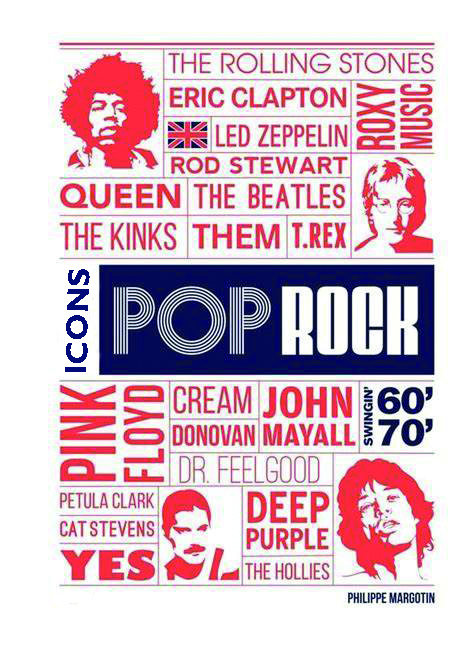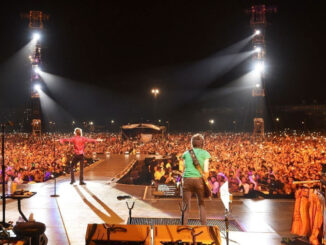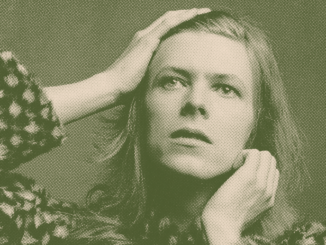
Judging by the front cover, one might expect Pop Rock Icons to be festooned with infographics. It isn’t. Instead, it’s a collection of photographs depicting “London’s Swingin’ 60s & 70s”. Rather than homogenise and cluster the music of these two decades, Margotin divides the music into genres.
With the biggest bands, The Beatles and The Rolling Stones, a single chapter is devoted to them. The other music genres given their own chapters are rhythm ‘n’ blues, mods and swingin’ London, guitar heroes, progressive rock, heavy metal, pub rock and glam rock. Each chapter has an introductory page with interesting and relevant facts.
Why collate a photography collection of musicians? The answer is simple because “fashion was driven by music and musicians” in the 60s & 70s. Furthermore, the choice of photographs selected are more than just savvy promotional photo shoots. For instance, The Beatles are captured together playing pitch and putt, looking rather unsophisticated. The alluring presence of the late founder of The Rolling Stones, Brian Jones, came across, and it was a wise choice to include all Rolling Stones images with him in them. There is even a photograph of Jones with John Lennon and Yoko Ono with a nervous-looking young Julian Lennon. Standing in the background is Roger Daltrey.
Concerning rhythm and blues, one learns that an early Jethro Tull started out in this genre before becoming a progressive rock band. The eye-catching photographs include Manfred Man singer Mike D’Abo wearing what appears to be pyjama bottoms with sockless shoes. Conformity and homogeny were evidently important for the Yardbirds, who are pictured with matching yellow shirts that were almost the exact shade of yellow as the wallpaper behind them. Them that featured Van Morrison were far less self-conscious and are captured publicly in the Ruislip Lido whilst other members of the public are swimming past, and a couple of cheeky kids do their best to photo bomb the shoot.
The mods and swingin’ London chapter was interesting as one saw the connection between the artists and the iconic London venues such as the Marquee. While a justly deserved double-page photograph of The Who is included, the author makes efforts to distinguish mods from other musicians and music fans, including “leather-clad rockers”. The greatest achievement from this, the largest chapter, is the diversity in the dress of the artists, from Cat Stevens in cowboy boots to Ray Davies dressing as a schoolboy, bearing an uncanny resemblance to ACDC’s Angus Young. This chapter also captures non-musicians, including Twiggy.
The link between venues and musicians is best captured in the shortest chapter of this book on pub rock. Residencies in local pubs got bands such as Eddie and the Hot Rods their Marquee gig, where The Sex Pistols supported them. Likewise, one learns how the progressive rock scene was linked to the launch of the International Times (IT) publication at the Roundhouse in Chalk Farm in 1966 and was associated with the “Spontaneous Underground” scene at the Marquee.
The chapter on heavy metal is mesmerising simply because, in most of the images, the bands look anything but metal bands. Ozzy Osbourne isn’t wearing black; instead, he wears flowery shirts from the late sixties. With the exception of the Glam Rock chapter, including Queen images from the 1980s when they moved away from this scene to symphonic rock, this chapter accurately distinguishes the differences between glam rock and progressive rock. The author correctly chose which artists to reference without including their images. Naturally, David Bowie had to be included, but thankfully the author didn’t succumb to populism by using the Aladdin Sane LP artwork.
For those who were fortunate enough to be part of any of these movements during this period, which was not an easy thing to do, this book will be an emotive journey. The images of the late Wilko Johnson and Christine McVie will prove to be even more poignant. Furthermore, Pop Rock Icons is unassuming. One would expect the guitar heroes chapter to be deluged with artists playing guitars or with guitars in the background. Jimi Hendrix is seen chilling in his London flat, smoking a cigarette and making a cup of tea. Best of all, through the forum of music, we see how a diverse generation during the “London’s Swingin’ 60s & 70s” discover who they truly were.
You can purchase a copy of Pop Rock Icons by Philippe Margotin here.





Be the first to comment